The Beauty Rules: 1980s
How beauty standards have changed over time and why we should stop paying them any mind.
“The ideal beauty is a fugitive which is never found."
Joan Rivers
In 1980, researchers compiled the measurements of Playboy centerfolds and Miss America contestants from 1959 to 1978. They wanted to assess any changes to the so-called “ideal” figure over the previous twenty years.
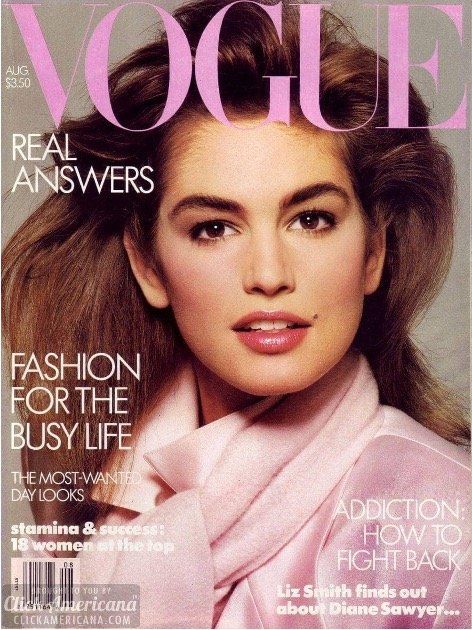
They found that both beauty queens and Playboy bunnies had grown progressively thinner in two decades. The average weight, bust measurement, and hip size decreased, whereas height and waist size increased.
The study also noted that over those same twenty years, there was an increase in magazine articles focused on weight loss in six popular women’s magazines.
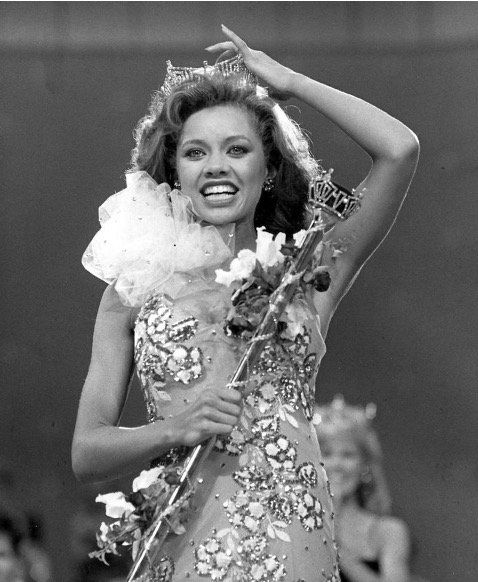
Ironically, this slender-trend for beauty ideals in popular media was happening at the same time that Americans, on the whole were, getting fatter.
If the media is responsible for the pressure felt by many women to attain these standards (and the accompanying anxiety, depression, and eating disordered behavior): Why doesn’t it impact every woman to such an extent?
Psychologists say it’s because beauty propaganda has the greatest influence on women who have internalized a thin ideal.
In my next post, I’ll talk more about the various ways someone can be socialized to adopt this internalized thin-ideal.
But for now, let’s look back at the 1980s. What were the beauty rules, and how were women affected by them? What cultural attitudes or events may have had an influence?
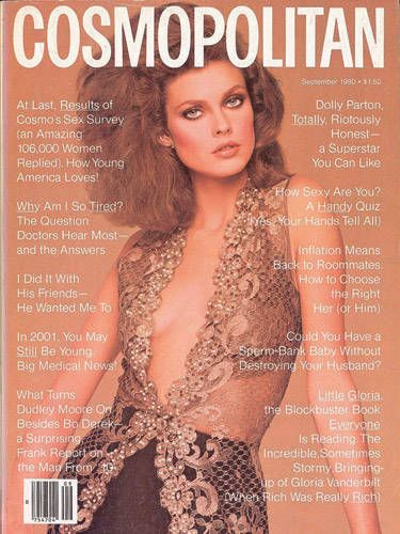
The decade of decadence
As the dust of twenty years worth of political upheaval settled in the 1980s, the Second Wave Feminists had made incredible progress.
In 1981, Sandra Day O’Connor would become the first woman nominated to the Supreme Court. Just a few years later, Geraldine Ferraro was tapped to be the first female vice-presidential candidate for a major party.
Women were earning more than half of the bachelor’s and master’s degrees in the country and made up one-third of doctoral candidates.
For perhaps the first time in history, little girls grew up dreaming of becoming whatever they wanted to be.
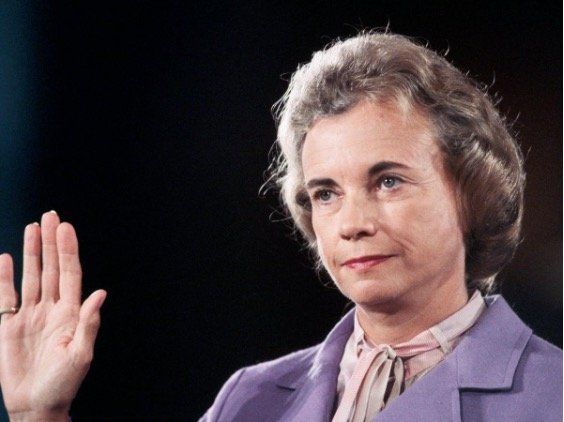
But two long decades of protests and political upheaval were more than enough for the baby boomer generation. They’d lived through The Vietnam War, the civil rights movement, social unrest, government scandals, and a recession and were ready for some peace, quiet, and prosperity.
Ronald Reagan’s vision for America came at the perfect time. He vowed to restore the free market, encourage private enterprise, and rehabilitate the American Dream. And indeed, his policies were responsible for prosperity not seen since right after WWII.
The Reagans brought glitz and glamour back to the White House, along with permission for Americans to confidently pursue success and affluence. The average eighties woman identified as a feminist, but you were more likely to see her at a shopping mall than a protest.
Television had become an even more significant part of Americans’ lives thanks to cable tv. The sitcoms in those days were a reflection of the times themselves. Shows like The Cosby Show, featured devoted wives and mothers who were also hard-working career women.
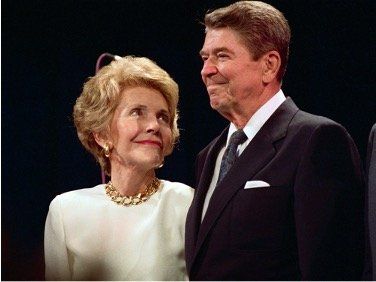
TV had a giant impact on fashion trends, especially when MTV made its debut in 1981. Video may have killed a few radio stars, but pop idols like Michael Jackson and Madonna had record-breaking success thanks to it. They could convey more of an image and get their music in front of millions of people at one time. This also meant fashion fads spread across the country like wildfire.
The birth of technology like the personal computer and cell phone improved the standard of living for wealthy American yuppies. Still, it would be some time before smartphones, Tik Tok, or Netflix proliferated (giving unprecedented access to unrealistic images of beauty).
The eighties was the decade of MORE: Big hair, loud fashion, neon color, fast cars, mega-hold hair gel, and acid-washed jeans, the more rips, the better.
Paradoxically, the eighties beauty rules were still about deprivation. When it came to the female body, LESS was still more.
The downside of having it all

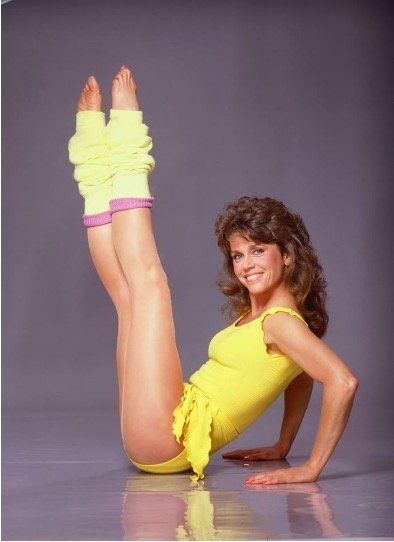
Eighties’ beauty ideals
It was the decade that brought us the supermodel. Christie Brinkley, Cindy Crawford, Iman, Elle MacPherson, Linda Evangelista…the list of eighties’ runway stunners is long. They were tall, slender, and strong.
A more muscular look for women was continuing to emerge due to advances in fitness and, in part, the feminist spirit. Muscle tone signified strength, capability, and independence.
Before the fitness craze of the 1980s, a woman aspiring to the cultural ideal needed only deny her appetite. But the stakes were raised, and now there was pressure to tone up. And the modern woman had little excuse to slack off when a VCR meant Jane Fonda could come right into her living room.
Remember the seventies superwoman? The 1980s’ lady wanting to get ahead had a bit more on her plate now—between her sky’s-the-limit career opportunities, family life, and Jazzercise classes.
Power suits were en vogue. Shoulder pads gave the impression of broader shoulders, suggesting strength. Still, the ideal figure was very thin.
The average woman’s BMI was around 25, while Cindy Crawford’s was said to be 19. In fact, the BMIs of several eighties supermodels ranged from just 17 to 20.
Fashions in the eighties showed off the legs, accentuated the breasts and sometimes even exposed the belly. Crop tops, leotards, and leggings left little to the imagination.
Reverberations

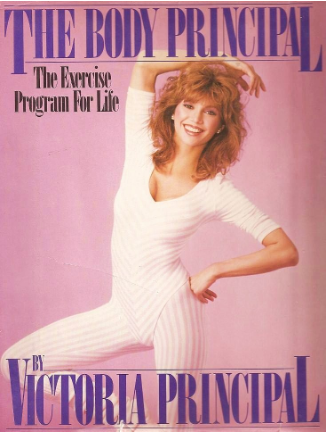
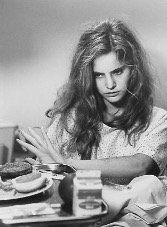
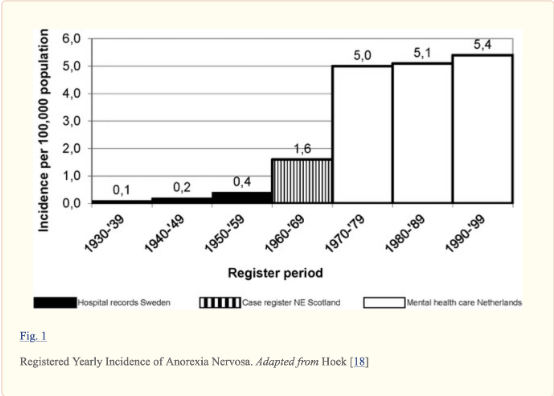
Anorexia appeared for the first time in the 1980 Diagnostic and Statistical Manual of Mental Disorders (DSM-III). (Bulimia wouldn't be added until 1987). Meanwhile, counseling centers expanded to support students with eating disorders.
This most deadly psychiatric disorder—on the public’s radar for the first time just a decade before—was suddenly the storyline of countless books, tv shows, and movies. And the seventies[1] had merely kicked things off with its record number of anorexia hospitalizations. The eighties saw the troubling pace hit its stride.
Fans watched and worried as stars like Princess Di, Karen Carpenter, and Tracey Gold wasted away before their eyes. Suspicions that these famous ladies were battling eating disorders swirled. Suspicions that were tragically confirmed in the case of Karen Carpenter, who lost her battle in 1983 at just 32. (Princess Diana and Gold would eventually be vocal about their own struggles.)


Thin-ideal internalization
Remember the thin-ideal internalization concept I mentioned earlier? Psychologists say it’s why certain women are more vulnerable to the debilitating, sometimes deadly effects of the unrealistic images around us.
And as technology evolves at an even quicker pace, these images proliferate exponentially.
In my next post I’ll go into the ways women are socialized to adopt this thin-ideal. Keep an eye out for it, as we’ll be going back in time to investigate the beauty rules of the 1990s!
X.O.
Dina B.
References & further reading:
Garner, David & Garfinkel, Paul & Schwartz, D. & Thompson, M.. (1980). Cultural Expectations of Thinness in Women. Psychological Reports. 47. 483-491. 10.2466/pr0.1980.47.2.483.
Kelly D. Brownell,
Dieting and the search for the perfect body: Where physiology and culture collide,
Behavior Therapy,
Volume 22, Issue 1,
1991
Dion, K., Berscheid, E., & Walster, E. (1972). What is beautiful is good. Journal of Personality and Social Psychology, 24(3), 285–290.
Calogero R.M., Boroughs M., Thompson J.K. (2007) The Impact of Western Beauty Ideals on the Lives of Women: A Sociocultural Perspective. In: Swami V., Furnham A. (eds) The Body Beautiful. Palgrave Macmillan, London.
Fasting Girls: The History of Anorexia Nervosa
By Joan Jacobs Brumberg



